Tibetan Cham Dance
- by Merry
- Last Updated: 2025-02-18
Cham dance, also known as " བཅམ " in Tibetan, translates to "dance of the gods." It is a religious dance within Tibetan Buddhism, believed to have originated from the construction celebration of the Samye Monastery during the Tubo period and evolved over time to become a fixed ritualistic dance in Tibetan Buddhism.
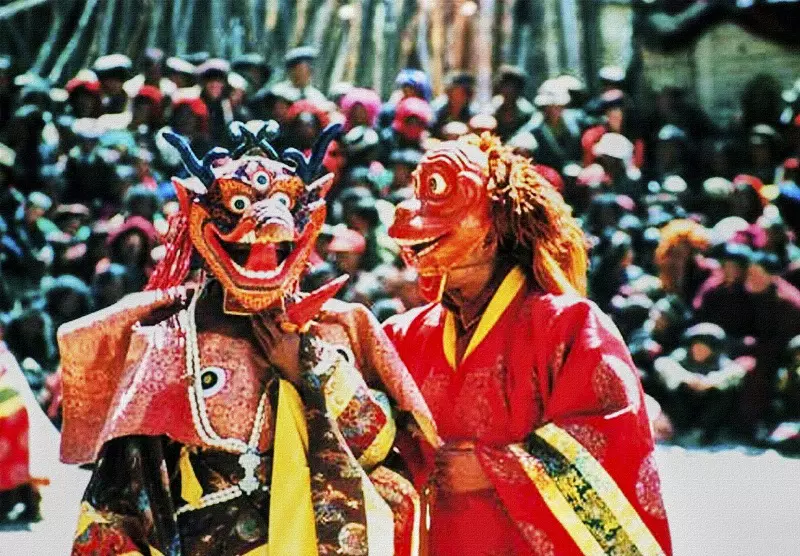
Cham dance is a vivid masked and ornate dance associated with various sects of Tibetan Buddhism and Buddhist festivals. Accompanied by traditional Tibetan musical instruments played by monks, these dances provide compassionate guidance to devotees and bestow merit upon all who perceive them.
Content Preview
Origin
According to tradition, in the 8th century, after the introduction of Indian Buddhism to Tibet, King Trisong Detsen vigorously promoted Buddhism, welcoming the master Padmasambhava to propagate the Buddhist teachings. Master Padmasambhava integrated the content of Indian Buddhism with some rituals, rites, and doctrines of the local Bon tradition in Tibet. Respecting the Tibetan inclination towards the worship of multiple deities, he incorporated various spirits from Bon into the protective deities, infusing elements of Buddhist Tantric sorcery into the original ritual dances of Bon. This fusion resulted in a form of temple religious dance that aimed to exorcise spirits, pray for abundant harvests, benefit future lives, explain karmic relationships, and propagate Buddhist stories. Known as "Cham," this religious mime dance gradually evolved and spread in Tibet, preserved in its entirety for over a thousand years, becoming a religious ceremonial dance passed down through the generations.
Religious Significance
Cham Dance is a tantric ritual. The religious dance itself relies on the shape of the human body and uses various movements, postures, music, costumes, and masks to enhance the image of the Buddha, so that the monks and people can see the true appearance of deities, protectors and other Buddhas who are usually invisible, making them more faithful in the teachings of Buddhism. This can achieve a level of publicity that cannot be achieved by any other art form, and play a role in praising Buddhism, in which its artistic charm lies.
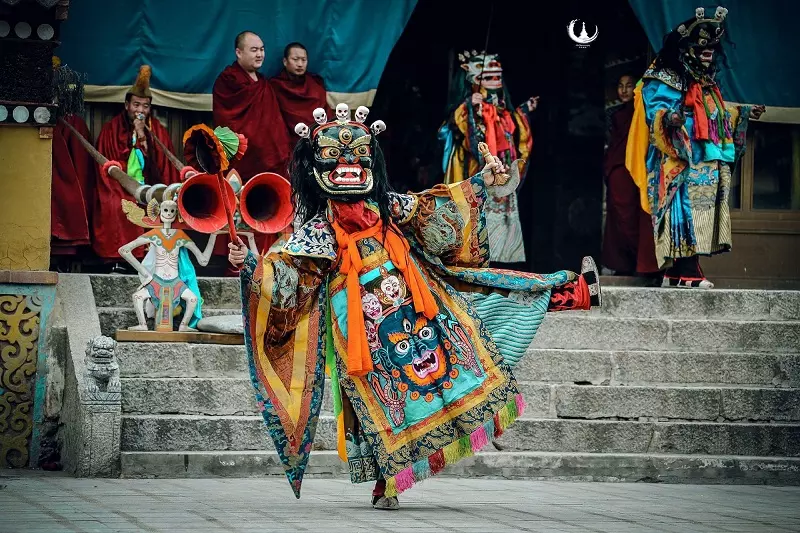
Process of Cham Dance
In the past, cham was not performed to the public because the objects of its performance were gods and ghosts rather than ordinary people. Later, it was gradually performed during major Dharma Assemblies to ward off evil spirits and bring blessings to believers in the world. In order to attend the sacrificial activities in person, believers have to travel thousands of miles away and set off to monasteries with their families several days in advance to worship the gods and seek the fulfillment of their family's wishes. The performance content and time in each sect and monasteries of Tibetan Buddhism are also different.
Prelude
As the prelude unfolds, monks engage in prayers while throwing colorful "Longda" into the sky and burning incense. The fragrant rising smoke and the colorful Longda rise gradually in the wind, sending everyone's prayers to the protectors in heaven. Dharma horns, gongs, and drums resound in unison as monks, adorned in tall yellow goose-feather crowns and clad in kasaya robes, chant sacred sutras in Sanskrit, marking the commencement of the Cham Divine Dance. Amidst the loud and solemn music of Suonas, trombones, drums, and Tibetan copper titaniums elevated on the roof of the temple, the monks file into, carrying dharma trumpets, holding dharma drums high, beating gongs, and carrying various ritual instruments. Two lions, symbolizing the eight lions guarding the lotus throne of Buddha Shakyamuni, engage in a ritual dance. This dance expresses the deep reverence and devotion towards the Buddha.
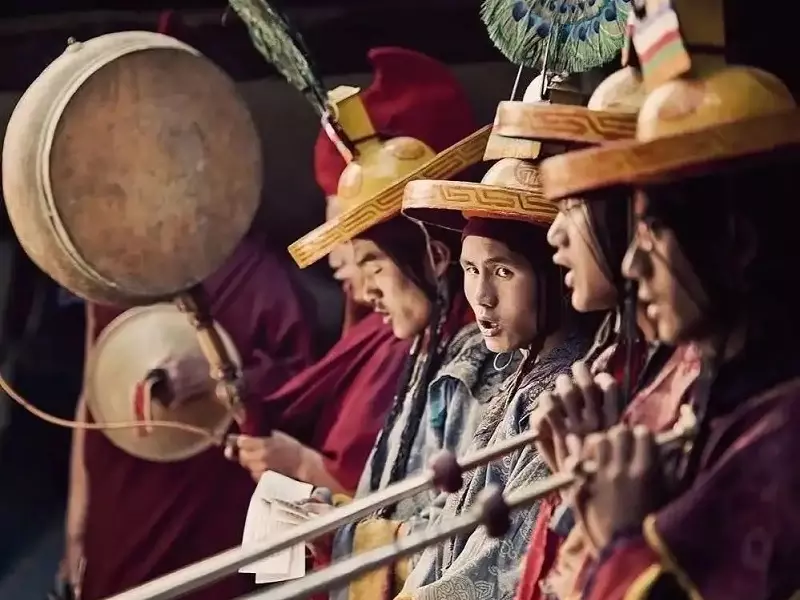
Start
The instrumental music resounds as the city gate opens. Following that, a multitude of gods and various animals make their appearance. The lamas in charge of the Cham performance, wearing divine animal masks and wielding ritual implements or weapons, enter in order of the hierarchy of the gods, indicating that various divine beings have descended to the mortal realm. Accompanied by awe-inspiring sacrificial music, these gods, while receiving the worship of the believers, simultaneously form a line, circulate the temple, and with raised hands and lifted feet, rotate and advance.
Development
Dance troupes dressed in various religious costumes take turns appearing. Some hold ritual instruments, others wield swords and blades, while some carry sacred images atop their heads. Their every movement is slow and dignified, each gesture exuding an ancient, primal charm. The performances include "Dharma Deity Dance," "Fierce Deity Dance," and "Vajra Deity Dance", all emphasizing the supreme power of divine beings. The Skeleton Dance, depicting mischievous spirits playfully interacting in the underworld, adds a touch of humor, while the Deer Deity Dance symbolizes blessings of fortune and prosperity. The Longevity Deity Dance and Crane Deity Dance promote kindness, generosity, and a long, prosperous life. Other segments represent Buddhist stories such as "Self-sacrifice to Feed the Tiger" and "Karmic Retribution," creating a spectacle that captivates the audience.
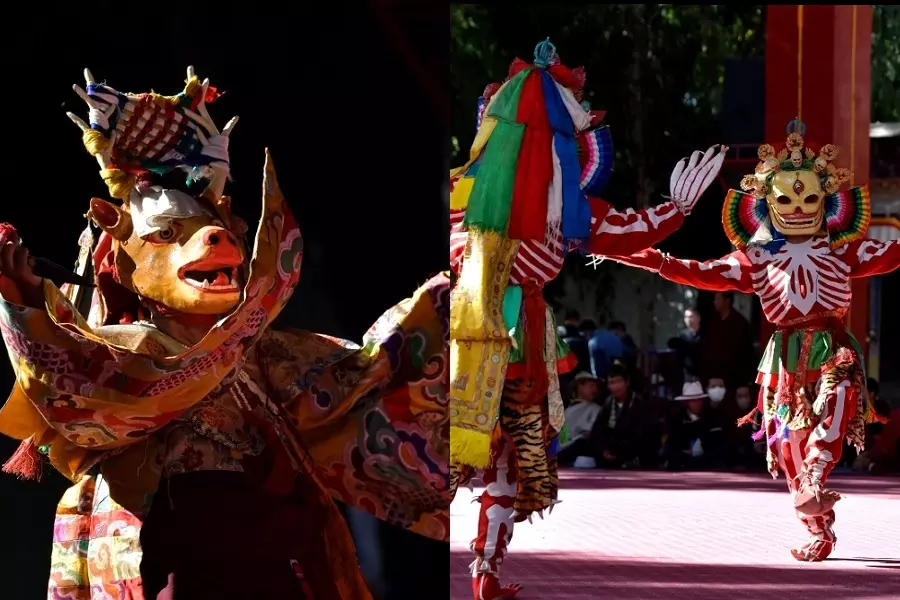
Among these various divine animal dances, the "Skeleton Dance" and the "Deer Deity Dance" stand out as the liveliest, most adorable, and dance-intensive, earning the affection of all spectators. Despite being religious dances, these two performances lack the solemn and eerie atmosphere associated with religious rituals. Instead, they endow people with spiritual joy and tranquility, instilling boundless hope for the future.
Culmination
The performance reaches its climax as monks enter the arena one by one, holding Vajra in their right hands and skull bowls in their left. They wear black-rimmed hats with multicolored khata and deep red robes adorned with colorful streamers and leap onto the venue. These ritual dance monks, in coordination with the sound of bronze gongs, chants, and drum beats, alternately crouched, bounced on one foot, and spun mid-air. In the deep sound of dharma trumpets, they used steady jumps and slow body changes to create a mysterious and solemn atmosphere of religious dance.
End
"Expelling evil spirits" is the last part of Cham Dance. After all the exorcism rituals are completed, the various deities gather the big and small evil spirits and place them on the demon leader "Torma", which is made of butter and tsampa. The demon leader "Torma" is then escorted by the "divine troops" and crowds and moved to an open space some distance away from the temple. There, firewood is piled up, and the Torma is set alight, turning to ashes. This marks the completion of the Cham ritual, which drives away all evil for the coming year and ushers in peace and blessings for both the temple and the people.
Black Hat Dance
There is also a special dance held on the eve of the iterated Tibetan New Year to commemorate the assassination of Langdarma by Lhalung Pelkyi in 842 AD. The performing monks, wearing black hats and robes, dance outside the palace until they are permitted to perform in front of Tsenpo and ultimately assassinate him. This dance symbolizes the triumph of good over evil.
The Black Hat Dance also belongs to Cham dance, and it's often depicted in paintings. The dance is mainly performed by monks and is divided into two levels: to achieve enlightenment and to destroy evil forces. The dance typically involves binding a skull and scarf together and tying them onto the handle of a purba (ritual instrument).
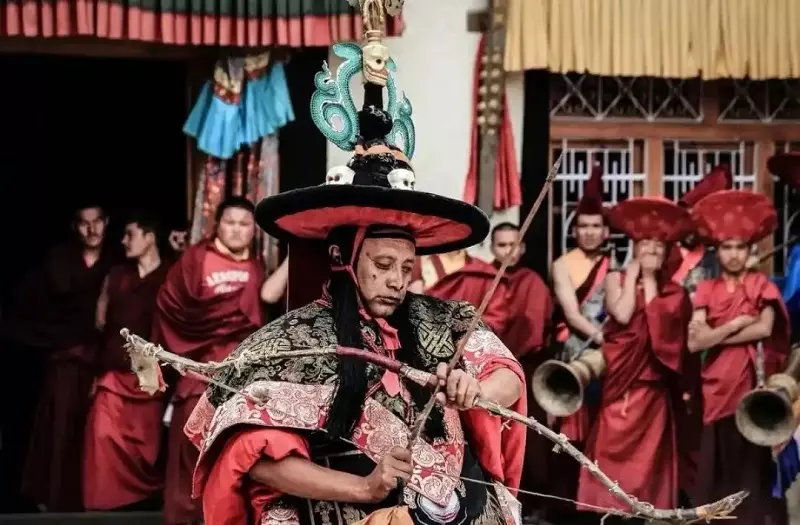
When to See Cham Dance
In Tibet, each major Tibetan Buddhist monastery and temple holds Cham Dance on the birthday of Sakyamuni, the Tibetan New Year and important religious festivals of Tibetan Buddhism.
In Bhutan, Cham Dance is performed in every Dzong in the country during annual religious festivals or Tshechu Festival. Cham Dance is sometimes performed by women with the villagers.
In India, Cham Dance is performed during cultural and religious festivals in Lahaul, Spiti, Sikkim, Ladakh and other places.
Conclusion
Cham Dance is considered a form of meditation and an offering to the gods. Combining visuals such as colorful costumes and masks, as well as rhythmic practice art such as musical instruments, Cham Dance not only embodies a deep respect for Buddhist teachings but also provides a visually pleasing performance. Tourists traveling to Tibet cannot miss the interesting Cham Dance in Tibet.
Related Articles
- Nyingchi Mingzhu Hotel
- Tibetan Thangka Painting
- Tibetan Festivals
- Travel to Tibet from Malaysia
- Lhasa to Shigatse Train
- Samye Monastery
- Drolma Lhakhang Monastery
- Top 10 Tibetan Monasteries
- Major Buddhist Holidays & Festivals of Tibetan Buddhism
- About Us
Email response within 0.5~24 hours.


